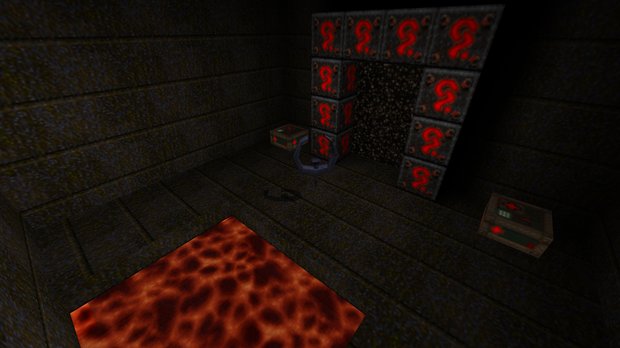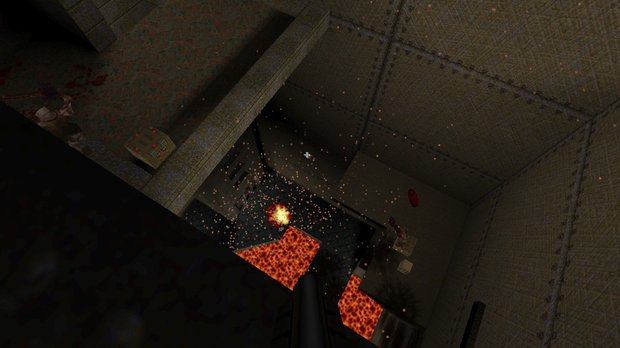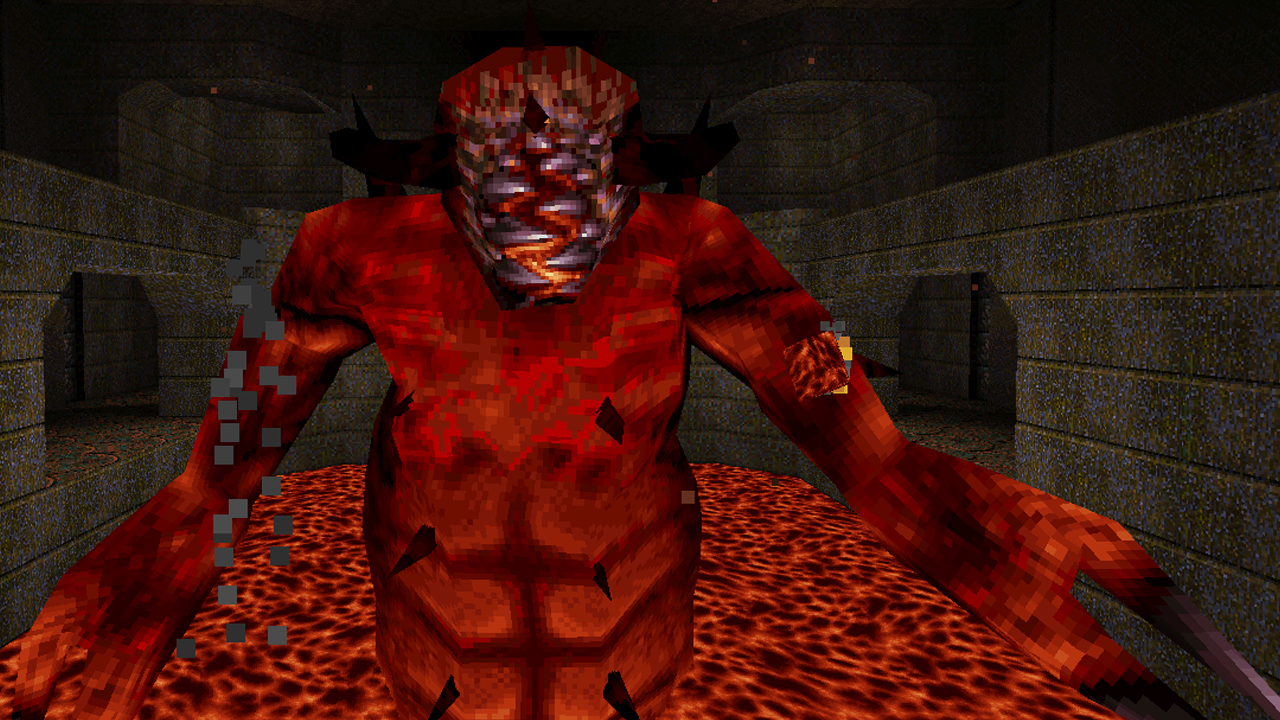The forgotten beauty of Quake's hidden Ziggurat map
Included in the free-to-distribute shareware version of Quake is a secret level called Ziggurat Vertigo. One of eight maps making up the first episode, Dimension of the Doomed, the level challenges players with a low-gravity environment, forcing a strategy rethink to compensate - Quake’s signature breakneck-speed combat and circle strafing give way to exaggerated leaps, balletic mid-air firefights and a far greater sense of commitment and consequence to each movement.

Unlike the game’s regular maps, where projectiles can be quickly dodged, Ziggurat Vertigo’s low-gravity results in players being left vulnerable as they gently float between platforms - grenades from the Ogres lumbering around given a fresh, wildly ricocheting unpredictability, while the ranged lightning attack of the Shambler - met in this level for the first time - is rendered especially dangerous due to being unaffected by gravity: if your feet leave the ground in its line-of-sight, expect to take heavy damage as you turn yourself into a drifting target.
The opening seconds of the map act as a subtle tutorial - players spawn up at a height, immediately aware of the reduced gravity as they slowly descend into a small pit which must then be leapt out of, hammering the point home. From there, it’s a climb (or sequence of hops) to the top to flick a switch, before descending and slipping through unlocked barriers to rise again on the other side of the map.
The low-gravity raises interesting questions about where the level actually takes place. Quake’s plot is all flimsy high-concept, the kind of scrawled-on-a-beermat premise id Software bashed out in the 1990s as an excuse to blast monsters in corridors. Its devil-may-care attitude to flitting between dimensions doesn’t give us much to go on, but taking into account major Quake influence H.P. Lovecraft’s fixations on primordial planes of existence below human perception, it could be inferred Ziggurat Vertigo’s realm is separate entirely from the rest of the episode - perhaps a deeper place where gravitational aberrations are more keenly felt?

Ziggurat Vertigo’s existence is remarkably understated given the level’s uniqueness and quality. Despise being a technical marvel and superb showcase for the capabilities of its engine, id sure makes you work to find it - a portal entrance is buried in the episode’s fourth level, The Grisly Grotto, accessed only by completing a (potentially lethal) sequence of puzzles and locating a secret cave. As its name suggests, the map emphasises verticality, with runic-themed towering lift shafts and jutting platforms pieced together by designer American McGee. The ‘Ziggurat’ part of the title likely refers to the structure which forms the centrepiece of the map’s first room, containing a Pentagram of Protection invulnerability pick-up which can be used to dive under the surface of the surrounding lake of lava to find a secret room.
While limited game demos still persist and free-to-play weekends allow brief access-all-areas experiences, shareware seems like something of an odd concept today. Quake emerged at the tail end of PC developers offering huge chunks of game for free as a temptation to purchase registered versions - back then, you could own a respectable library of substantial (in particular, first person-shooter) episodes without paying a penny. The game’s first episode is arguably its best, and Ziggurat Vertigo a particular gem: it seems almost unthinkable from a marketing point of view now that a developer would give away such a satisfying portion of its AAA game for keeps - less a taster, more a main course on the house - while not only throwing in one of its most interesting, original maps, but also deliberately hiding it.
Though the internet access was gaining popularity by the time of Quake’s 1996 launch, many players - including myself back in the day - would have still been offline, obtaining the shareware version from magazine cover discs. It’s quite possible many of these players never stumbled upon Ziggurat Vertigo in the game’s heyday without the aid of an FAQ. Initially, I only played it thanks to sneaky level selecting via the drop-down console.
Weekly digests, tales from the communities you love, and more

id’s genius is in its frugal use of the low-gravity gimmick - Ziggurat Vertigo is the only map in both the shareware and retail releases to feature such an environment, and the relatively simple level can easily be blasted through in ten or 15 minutes, ensuring its unique concept remains an enticing anomaly, never diluted by repetition. Aside from offering a unique challenge, Ziggurat Vertigo also functions as a tantalising glimpse at the possibilities of a then-unmatched engine - technology which would go on to power several games over the following few years, and the form the basis of GoldSource, the tech which the revolutionary Half-Life was built on.
By simply tweaking gravity parameters for the purposes of one level, id not only demonstrated how flexible, robust and capable of surprising its engine was, but also how technically outclassed the competition - notably Duke Nukem 3D’s sprite-based Build engine - had immediately become. The impact of Quake’s real-time lit, 360-degree polygon environment was only amplified by the low-gravity novelty: here was a world which could be bent and twisted, but interactions between the player, enemies, objects and the environment remained consistent.
Despite previous shooters - notably 1995’s Descent - having already made the leap to fully-3D worlds, Quake’s powerful underlying technology coupled with id’s customary smart level design, solid multiplayer experience and none-more-satisfying gunplay made it the new benchmark. Swapping enemy and weapon sprites for polygon models, alongside the ability to look around without experiencing the kind of immersion-breaking visual distortion which plagued other FPS engines simulating true 3D, gave a then-startling impression of tangibility to Quake’s world.

Quake signaled the beginning of the end for sprite-based shooters, with the last such major games - among them Exhumed/Powerslave, Blood, Shadow Warrior, Redneck Rampage and LucasArts’ Outlaws - all arriving within a year of release. Once players acclimatised to Quake’s new-era-heralding sense of physical presence, competitors built on older technology, no matter how unique or expansive their feature sets, suddenly seemed flat - almost like faked-perspective fairground shooting galleries - by comparison to the more solid environment offered by id.
In hindsight, Ziggurat Vertigo represents a real “What if?” moment, a sneak peek at where the FPS would be taken in years to come. If Quake’s sprite-usurping-polygon technology can be compared to the leap from acoustic to electric guitar, Ziggurat Vertigo is akin to stamping on a distortion pedal for the first time. Back in 1996, my 12-year-old mind was blown by the sudden expansion of expectations ushered in by just this one map - the idea that games now had the power to subvert familiar, learned mechanics in an instant, that they could effectively remix elements of themselves to generate entirely new experiences level-to-level. Outside the FPS genre, I recall a similar feeling playing The Hills Have Eyes skirmish map included on Command & Conquer: Red Alert’s Aftermath expansion pack a year or so later - a map where the usually helpless civilian NPCs turn on the player with surreal, terrifying force, another case of having a curveball thrown without forewarning.

Though I had never paid much attention to the Doom community’s efforts to augment the core game, I fell hard for Quake’s flexibility, and became keen on console tinkering and map building. The potential displayed by Ziggurat Vertigo’s gravity tweak was certainly embraced by the mod and total conversion scene, and soon enough the game’s malleable engine was contorted into experiences ranging from the nascent Team Fortress, to fully-fledged racer Quake Rally, to side-scrolling platformers. I ploughed hours into a total conversion called Slide in my youth: a rough-around-the-edges first person downhill racer on hoverboards across sprawling slalom maps, which played with gravity and friction in ways which felt like an extension of Ziggurat Vertigo’s movement, souped-up and made competitive, with a distinct arcade sensibility. It’s a testament to id’s engine that catching air and landing jumps in the mod felt more satisfying than in many dedicated sports games.
Playing Ziggurat Vertigo nearly 20 years on remains an intriguing prospect. Quake’s graphics and animation have dated enormously, while the low-gravity concept has been reworked countless times in other games, but it feels like 10 or 15 minutes’ worth of gameplay that belongs in a design tutorial on how to take an intense game and intensify it further with one simple change and an environment constructed explicitly to exploit that change. The towering, multi-tiered structures, replete with overlapping bridges, grates to peek through and holes to slip down several storeys positively scream a statement of previous generational constraints being cast aside, that the FPS was now truly a vertical as well as horizontal realm. Lowering the gravity permits players to spend more time in this 3D space with each leap and drop, reveling in a sheer sense of momentum. With Ziggurat Vertigo, id found a brilliant way to fully flaunt its engine in all the enhanced clarity of slow motion without actually slowing down the action - the perfect blend of tech demo and offbeat FPS experience.
Dan is a freelance writer who has written for numerous publications over the years, including AskMen, GamesRadar, and Goodreads.



